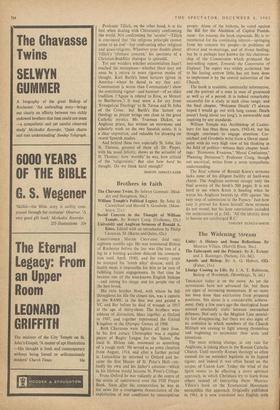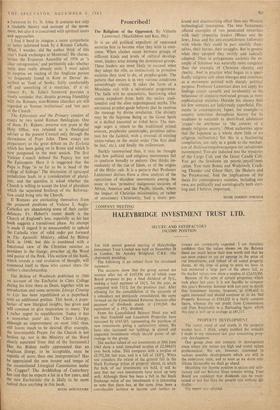The Widening Stream
Unity: A History and Some Reflections. By Maurice Villain. (Harvill Press, 36s.) The Episcopate and the Primacy. By K. Rahner and J. Ratzinger. (Nelson, 12s. 6d.) Apdstle and Bishop. By A. G. Hebert, DD. (Faber, 21s.) Liturgy Coming to Life. By J. A. T. Robinson, Bishop of Woolwich. (Mowbrays, 7s. 6d.)
THEOLOGY today is on the move. As yet the movements have not advanced far, but there are signs of increasing momentum. If no more has been done than extrication from prepared positions, this alone is a considerable achieve- ment. Only a few years ago the theological front seemed absolutely static between entrenched defences. Not only is the Maginot Line mental- ity fast disappearing, but there are also signs of an armistice in which members of the Church Militant are ceasing to fight among themselves and beginning to reconsider their aims and intentions.
The most striking change, at any rate for Anglicans, is taking place in the Roman Catholic Church. Until recently Roman theology so often seemed (to an outsider) legalistic in its logical rigour, and indeed it was often based on the corpus of Canon Law. Today the wind of the Spirit seems to be effecting a more spiritual approach, in which Christians try to learn from others instead of instructing them. Maurice Villain's book on the Ecumenical Movement exemplifies this approach. Originally published in 1961, it is now translated into English with a foreword by Fr. St. John. It contains not only a readable history and account of the move- ment, but also it is concerned with spiritual issues and approaches.
1 find it hard to imagine a more sympathetic or better informed book by a Roman Catholic. What, 1 wonder, did the author think of this year's frank exchanges at Montreal? He charac- terises the Evanston Assembly of 1954 as `a clear retrogression,' and pertinently asks whether unity does really already exist. I must admit to surprise on reading of the Anglican parson `so frequently found in Kent or Devon' de- scribed as `fond of books, fairly comfortably off and something of a musician.' 0 si sic onines! Fr. St. John's foreword provides .a timely reminder that, despite growing friendship with the Romans, non-Roman churches are still regarded as `human institutions' and `not part of the Church.'
The Episcopate and the Primacy consists of essays by two noted Roman theologians. One of them, Fr. Rahner, persona non grata at the Holy Office, was retained as a theological adviser at the present Council only through the shrewdness of Pope John. These essays are preparatory to the great debate on De Ecclesia which has been going on in Rome and which is now postponed to the next session. The first Vatican Council defined the Papacy but not the Episcopate. Here it is suggested that the Pope is Pope 'in so far as he is head of the college of bishops.' The discussion of episcopal jurisdiction leads to a consideration of plural- ism; and the question is asked whether the Church is willing to accept the kind of pluralism which the separated brethren of the Reforma- tion could bring into the Church.
lf 'Romans are extricating themselves from the prepared positions of Vatican I, Anglo- Catholics are abandoning some of their earlier defences. Fr. Hebert's recent death is the Church of England's loss, especially as his last book suggests a transitional phase. An attempt Is made (I regard it as unsuccessful) to uphold the Catholic view of valid order put forward in The Apostolic Ministry, edited by Bishop Kirk in 1946; but this is combined with a functional view of the Christian minister as president in the liturgy, preacher of.. the Word and pastor of the flock. This section of the book, whieh reveals a real evolution of thought, will commend itself to those who cannot share the author's churchmanship.
The Bishop of Woolwich published in 1960 an account of the Eucharist in Clare College during his time there as Dean, together with an introduction and some sermons. Liturgy Coining to Life has been republished as a paperback with an additional preface. This book, a popu- lariser of new liturgical insights, has given and will continue to give inspiration to many. Yet I rather regret its republication. Today it has a somewhat passe air. The Clare Liturgy, although an improvement on most 1662 rites, still leaves much to be desired. (For example, the interminable Prayer for the Church is not broken up, nor is the Ministry a the Word clearly separated from that of the Sacrament.) Has the Bishop really appreciated that an Anglican liturgy, to be 'acceptable, must be capable of more than one interpretation? Has he appreciated the new temper and tempo of the reconstituted Liturgical Commission under Dr. Coggan? The Archbishop of Canterbury has said that he expects a lot in a few years, and the new Eucharistic rite is likely to be more radical than anything in this book.
HUGH MONTI:FIORE







































 Previous page
Previous page